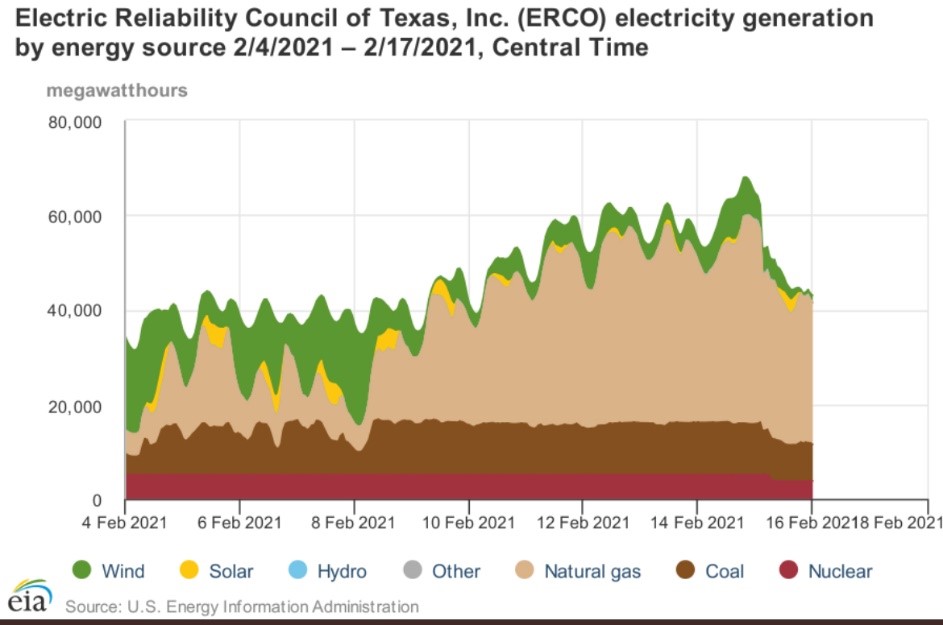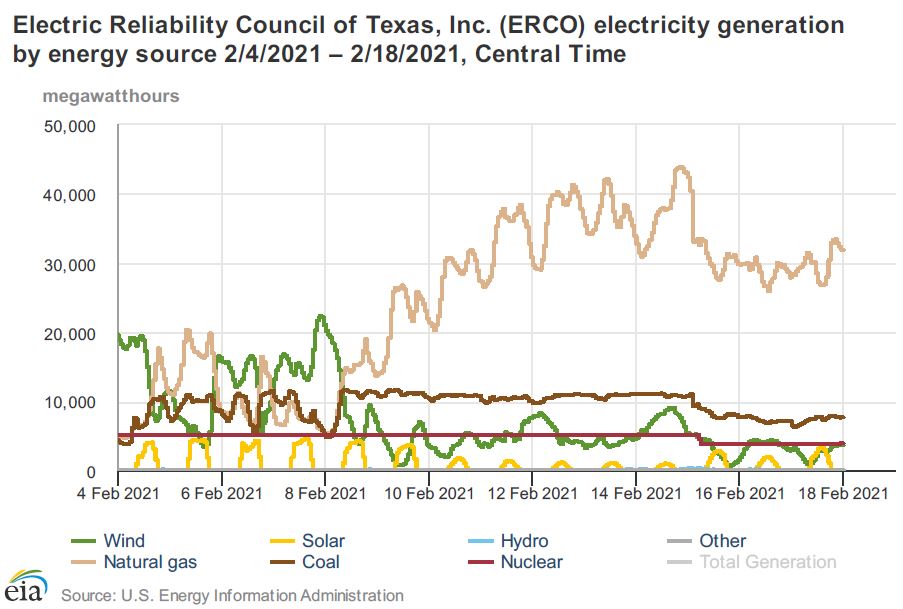While political pundits and policy analysts investigate the causes of last week’s Texas energy freeze, it is important to recognize that, while all generation forms saw outages, natural gas provided for the majority of electricity generation.
Both sides of the political aisle have been quick to place blame for the rolling blackouts, but the clear-cut data on Texas’ power generation and capacity over the past week demonstrates natural gas generation delivered.
Generation Analysis

In 2019, a majority (~53%) of Texas electricity was generated with natural gas, followed by coal (19%), wind (17%), and nuclear (8.6%) according to EIA data. When temperatures fell below zero last week, the spike in electricity demand surged by 50% to a 69,000 megawatts (MW) peak.
With temperatures plunging into sub-zero territory and in response to peaking demand, natural gas generation ramped from 10 GW to 37 GW, filling 136% of the demand increase, according to Energy Information Administration data. In fact, natural gas generation ramped up to provide two-thirds of all generation in the Texas market during this crisis, according to the EIA.
While the lack of winterized energy infrastructure indeed caused natural gas generation to fall off by 16% on Feb. 15, EIA data also shows coal, nuclear, and wind generation declined by 22%, 24% and 58%, respectively.
For sure, “these extreme weather conditions impacted every aspect of the Texas energy supply chain,” said Todd Staples, president of the Texas Oil and Gas Association.

In a state that prepares for 100 degree not one-degree days, freeze-offs constrained production, and frigid temps and rolling blackouts contributed to taking gas and other thermal generation capacity offline.
“Natural gas is playing a very important role and very reliable role,” Staples said. “If it weren’t for that product, there would be almost no power in this state right now.”
Reliability, PJM Preparation
Wind and solar electric generation capacity is expected to grow this year, federal data suggests, with underlying support from natural gas. But as scientists anticipate more heavy storms and climate-related natural disasters to occur in the coming decades, the crisis in the southwest should serve as an indicator that we need to produce and add more natural gas to the grid, not less.
As we consider the question of reliability beyond the Texas market, a modern, expanded natural gas pipeline and infrastructure network ensures energy can move efficiently to the regions that need it.
In fact, these infrastructure constraints are exactly what the North American Electric Reliability Corp (NERC) warned about a few months ago in their annual Winter Reliability Assessment, flagging reliability risks during extreme weather events.
“During extreme and prolonged winter conditions, vital natural-gas fuel supplies for electricity generation can be at risk in New England, California and the southwestern United States,” NERC states.
Here in the northeast, our electric power is distributed through the multi-state PJM Interconnection – the nation’s largest electric grid, serving more than 65 million Americans, 12 states and Washington, D.C. – and has the “winterized” infrastructure that’s able to power through heavy snowfall and chilling temperatures. A key component to PJM’s reliability strategy is having a diverse fuel mix, robust reserve margin, regional planning and winter preparation, a release states.
“Our power plants are built for freezing temperatures and winterized,” PJM spokesperson Susan Buehler said. “PJM and its member utility companies plan for extreme weather. Reliability is our most important responsibility.”
Balancing the electric grid is complex, and one that needs a resilient resource that can be turned on or off in the matter of minutes. As we shift our attention and policy priorities to creating a more reliable electric grid, natural gas will be absolutely critical to meeting modern energy demands, especially at their peak.




